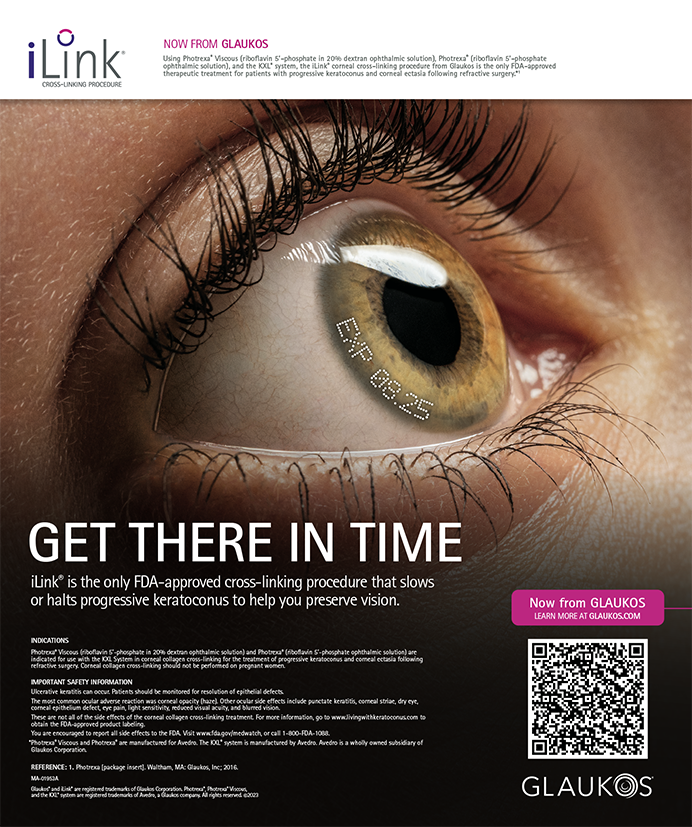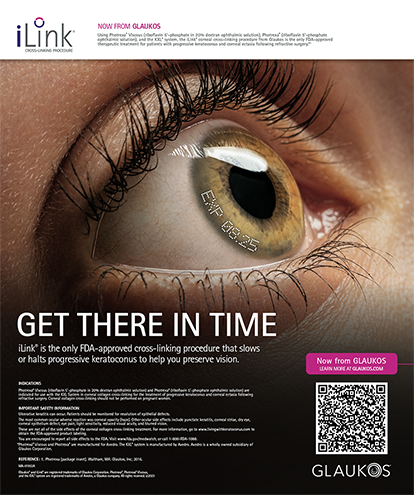Ophthalmologists must consider many factors when trying to optimize visual outcomes after cataract surgery in patients with glaucoma. One of the most important is the choice of IOL, both in terms of the material and design and especially regarding the postoperative refractive state planned for the patient. Cataract surgery can definitely improve the quality of vision of patients with even severe glaucoma, but preexisting visual field defects and lost contrast sensitivity will persist even after a successful cataract procedure. These functional defects can adversely influence the desired refractive outcome, particularly for patients who want to be spectacle free after surgery. For these reasons, surgeons must expertly manage glaucoma patients’ expectations and be aware of the potential benefits and limitations of the different IOL options in this population. In particular, the need for caution in pursuing a spectacle-free postoperative outcome rises as the severity of the glaucoma increases.
OCULAR HYPERTENSIVES AND PATIENTS WITH EARLY GLAUCOMA
Patients with ocular hypertension (OHT) and those with very early, stable glaucoma can benefit from any of the available IOL and refractive options. I discuss all of the possibilities with these patients in the same way I would with a cataract patient who does not have OHT or glaucoma. For those interested in monovision or a multifocal IOL, I add to my informed consent a short discussion of the possibility that future disease progression could render these refractive choices somewhat less helpful, but I do not discourage these patients from selecting any IOL or refractive alternative. Rather, I use the same selection criteria and expectations management as I would for any cataract patient.
PATIENTS WITH MODERATE TO SEVERE GLAUCOMA
Surgeons must take permanent visual deficits into account when choosing an IOL and desired postoperative refractive outcome. Decreased visual function due to glaucoma could reduce the intended effect of some lenses. A few specific options merit special consideration in this population.
Aspheric IOLs
Some newer IOL technologies may be quite beneficial to this population. Moderate to severe glaucoma can decrease patients’ contrast sensitivity.1 Because aspheric IOLs reportedly produce better contrast sensitivity than conventional lenses,2-4 I favor aspheric IOLs for patients with glaucoma, and I have used these lenses successfully in these individuals. I also find aspheric lenses to be highly biocompatible and to have excellent centration.
Toric IOLs
In my experience, modern aspheric toric IOLs can be used very successfully in glaucoma patients, even those with severe disease. I typically would not select a toric IOL with its additional cost if I thought that glaucoma had reduced a patient’s central visual potential, but for many of my glaucoma patients, these lenses provide excellent postoperative results. Aspheric toric IOLs can be particularly effective at reducing astigmatism induced by previous filtering surgery.
Of note, I do not use toric IOLs if I am combining the cataract procedure with traditional filtering surgery, because the postoperative corneal astigmatism is too difficult to predict. These lenses can be used successfully, however, when cataract surgery is combined with a more minimally invasive angle-based glaucoma surgery. It is debatable whether these IOLs should be used in the setting of exfoliation disease because of the potential for a decentered lens. Although this may not be an absolute contraindication, thorough informed consent is required.
Monovision and Presbyopia-Correcting IOLs
Other newer IOL technologies and common refractive options may not be advisable in patients with moderate to advanced glaucoma. Although these options are not absolutely contraindicated, I tend to discourage patients with advanced glaucoma from two refractive alternatives in particular.
Monovision
Monovision can be very effective in motivated patients if both of their eyes function normally and they can achieve sensory adaptation. In patients with advanced glaucoma, a permanent visual defect sometimes does not allow one or both eyes to function independently at an adequate level to support monovision. This can be true even if the patient successfully used monovision contact lenses years earlier (Figure). I therefore usually do not recommend monovision for patients with advanced glaucoma. If one of these individuals is extremely motivated to pursue this option, I generally insist on a contact lens trial first.
Presbyopia-Correcting IOLs
Multifocal IOLs can provide spectacle-free postoperative vision to many patients, but the technology is not without its limitations. The ideal candidate for a multifocal IOL is motivated and has a cataract but otherwise normal eyes. Unfortunately, there is little published data to guide the use of multifocal IOLs in this patient population,5,6 so surgeons are left mostly with anecdotal experience. Current multifocal IOLs can reduce contrast sensitivity compared with monofocal lenses.7,8 (The studies just cited used spherical multifocal IOLs. Newer aspheric multifocal IOLs might perform better in terms of contrast sensitivity.9) Because patients with moderate to advanced glaucoma likely already have decreased contrast sensitivity, a further reduction by the IOL is not desirable. Someone with advanced glaucoma, decreased contrast sensitivity, and visual field compromise—often very near fixation—likely will not benefit from the potential advantages of a multifocal IOL. Considering the out-of-pocket expense for this technology, the cost-benefit ratio for these patients is unfavorable.
Another consideration in this population is the effect of multifocal IOLs on visual field testing. Little has been published on the subject, but at least one study reported a reduction in visual sensitivity of up to 2 dB, as measured by standard automated perimetry, in patients with a multifocal IOL compared with phakic controls.10 The researchers found a reduction of 0.8 dB in the multifocal group compared with controls who had a monofocal IOL. After controlling for other variables, the investigators felt that the decrease in sensitivity related to the multifocal IOL design and not to pseudophakia alone. Such a reduction could be significant relative to the interpretation of future standard automated perimetry.
Until more definitive studies are conducted, I will not recommend multifocal IOLs to patients with significant glaucoma. Accommodating IOLs might be more acceptable in these patients in terms of contrast sensitivity, but these lenses certainly have their own limitations in all patient populations.
CONCLUSION
Surgeons should carefully discuss IOL selection and refractive options with patients who have glaucoma. For individuals with OHT or early glaucoma, all available modalities merit consideration with little modification. A patient with moderate to severe glaucoma, however, needs to be informed of the potential limitations of some alternatives.
This article is reproduced with permission from Glaucoma Today’s May/June 2014 issue.
Norm Zabriskie, MD, is an associate professor, and he is vice-chairman and director of clinical operations for the John A. Moran Eye Center at the University of Utah School of Medicine in Salt Lake City. Dr. Zabriskie may be reached at (801) 585-3071; norm.zabriskie@hsc.utah.edu.
- McKendrick AM, Sampson GP, Walland MJ, Badcock DR. Contrast sensitivity changes due to glaucoma and normal aging: low-spatial-frequency losses in both magnocellular and parvocellular pathways. Invest Ophthalmol Vis Sci. 2007;48(5):2115-2122.
- Kershner RM. Retinal image contrast and functional visual performance with aspheric, silicone, and acrylic intraocular lenses. J Cataract Refract Surg. 2003;29:1684-1694.
- Packer M, Fine IH, Hoffman RS, Piers PA. Improved functional vision with a modified prolate intraocular lens. J Cataract Refract Surg. 2004;30(5):986-992.
- Bellucci R, Scialdone A, Buratto L, et al. Visual acuity and contrast sensitivity comparison between Tecnis and AcrySof SA60AT intraocular lenses: a multicenter randomized study. J Cataract Refract Surg. 2005;31(4):712-717.
- Kumar BV, Phillips RP, Prasad S. Multifocal intraocular lenses in the setting of glaucoma. Curr Opin Ophthalmol. 2007;18:62-68.
- Teichman JC, Ahmed IIK. Intraocular lens choices for patients with glaucoma. Curr Opin Ophthalmol. 2010;21:135-143.
- Souza CE, Mucciolli C, Soriano ES, et al. Visual performance of AcrySof apodized diffractive IOL: a prospective comparative trial. Am J Ophthalmol. 2006;141:827-832.
- Vingolo EM, Grenga P, Iacobelli L, Grenga R. Visual acuity and contrast sensitivity: AcrySof Restor apodized diffractive versus AcrySof SA60AT monofocal intraocular lenses. J Cataract Refract Surg. 2007;33(7):1244-1247.
- Li JH, Feng YF, Zhao YY, Lin L. Contrast visual acuity after multifocal intraocular lens implantation: aspheric versus spherical design. Int J Ophthalmol. 2014;7(1)100-103.
- Aychoua N, Montolio FGJ, Jansonius NM. Influence of multifocal intraocular lenses on standard automated perimetry test results. JAMA Ophthalmol. 2013;131(4):481-485.


